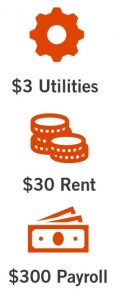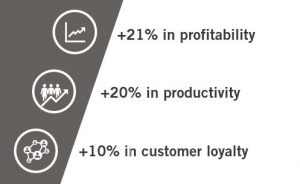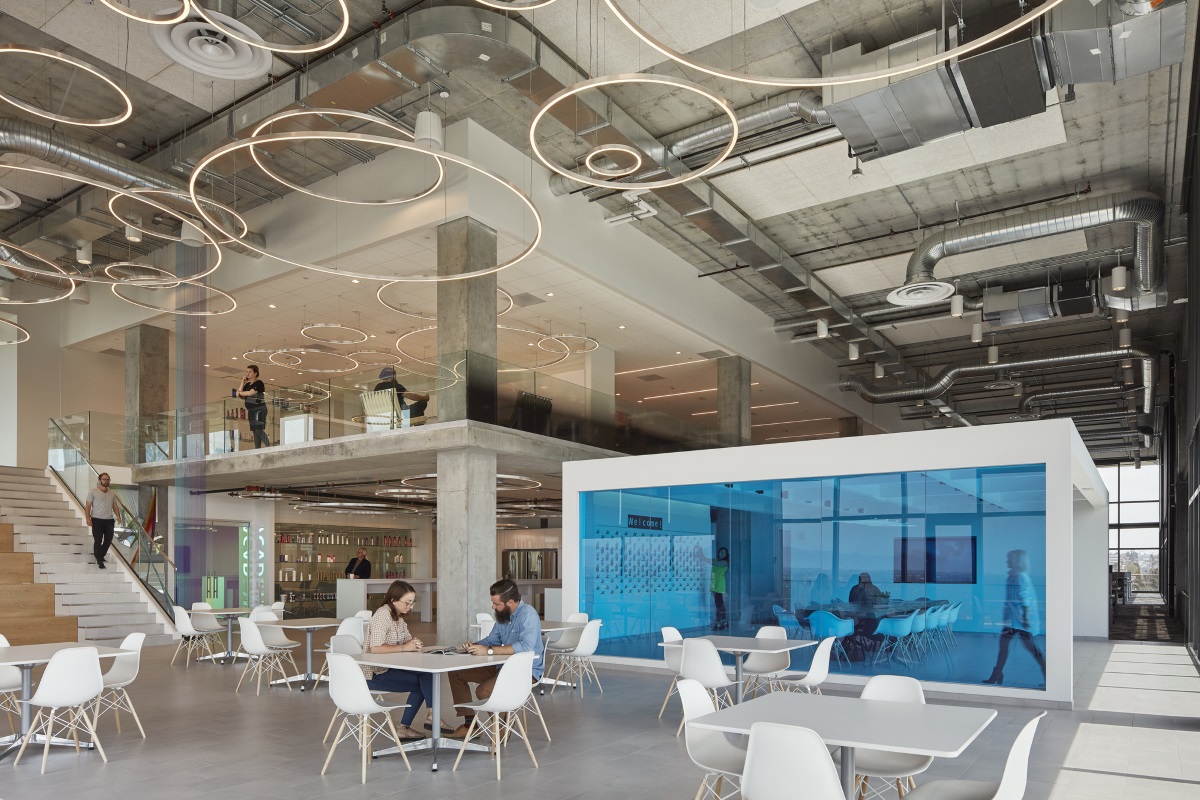by Cynthia Milota — February 2020 — In this era of big data, the use of Post Occupancy Evaluations (POEs) has new potential to enhance workplace assessments. POEs gather information to measure and predict how employees interact with their work environments. POEs produce quantitative and qualitative data using pre-specified, industry-tested measures. Unlike previous iterations of POEs which often focused on the physical attributes of the space, this discussion examines POEs through an employee experience lens.
POE benefits and challenges
Much has been published on the benefits and challenges of POEs. This literature spans from risk/reward and Return on Investment to lack of expertise in the architecture/design profession to liability concerns. Salient benefits/challenges for Facilities professionals are distilled here.
The benefits of POEs:
- Identify potential issues and proactively address findings
- Provide data to inform decisions and resource allocation (pre and post project)
- Establish a baseline for continuous improvement
The challenges of POEs:
- Lack of staffing resources to conduct studies and execute on the findings
- Too expensive and time consuming, with difficulty in ascertaining actionable outcomes
- Reluctance to ask questions and set unrealistic expectations for change
Despite the benefits of POEs, they are rarely conducted. One recent survey revealed that POEs were performed on less than 5% of all US projects (Hiromoto, 2015), yet they are increasingly mandated in public projects around the globe. Developing a POE strategy and cadence for your organization is not a one-size-fits-all activity. Conducting POEs will assess the successes and address the challenges of a completed or ongoing project.
working towards best practices
When was the last time you had the opportunity to check-in on a recent project?
- Does the new agile room model support the team’s use?
- Is the quiet zone seating adequate for employee needs?
When was the last time your team systematically examined an on-going or completed project to better understand its employee impact?
- Are employees taking advantage of the expanded hours for the grab n go?
- What impacts do the new security procedures have on visitor experience?
We haven’t heard any complaints, so all’s good, right?
As facilities professionals we oversee millions of dollars of corporate real estate capital expenditures and control operational processes, yet we rarely validate how our workplace investments are doing. We are over-taxed, understaffed and working hard to meet all the budget and schedule demands of our projects. Our team’s success measures of on-time and within budget were met. Most of our current systems do not incentivize closing the loop.
And more to the point, what would be gained by asking a bunch of questions?
If you can’t measure it, you can’t improve it (Peter Drucker)
People analytics and POEs
Let’s re-frame the questions from being about the space to being about the people using the space. Instead, let’s assess key experience indicators (Sharon, 2018), and how the space is working for the people and their business. Post Occupancy Evaluation tools can be used to assess employee workplace experience.
POE: Building your research
When planning a Post Occupancy Evaluation, begin by outlining the project goals (see examples of goals). Understanding the “why” behind a project is essential. Once the goals are established, consider questions that explore how your employees can accomplish the project goals (see examples of questions topics). With questions determined, explore data gathering techniques that answer the questions (see examples of data gathering methods).
With the data gathering complete, assess the findings, develop an action plan for implementing on findings and report back to study participants. The goals of the project and the nature of the questions will inform the scope of potential changes: operational; behavioral; organizational; or physical.
Start a post occupancy evaluation today
Here are 11 tips to consider when planning, implementing and acting on your POE:
- Align with leadership first
- Make your pitch to conduct POEs with leadership and align on goals of the study.
- Use leadership engagement to combat against NIMO (“not in my organization”).
- Only measure things with the potential for change
- Do not ask about the quantity of meeting rooms in a certain department, if there is no way of adding rooms. Instead focus your attention on the use and properties of existing rooms.
- Engage the stakeholders in the process
- Agree from the start on the scope of the study and the potential outcomes.
- Preview upcoming steps with stakeholder leadership to inform and garner their support.
- Start small
- Begin with a low-profile project, testing your questions, data gathering tools and mechanism for acting on the information gathered.
- Customize the study to your organization. Ideas could include: use of the cafeteria after lunch hours; demand for special spaces like prayer and mother’s rooms.
- Seek assistance in study design
- Build the study design with outside expertise.
- Consider third-party resources:
Gartner (robust surveys for member organizations)
Survey Monkey (pre-made questions on a variety of topics)
Leesman Index (online survey tool to measure employee experience
Center for the Built Environment (researcher and industry collaboration)
Work & People Analytics (measuring workplace experience)
- Self-perform data collection
- Much is learned in data collection, with wisdom in the anecdotal information that comes up during the process. The facilities team will be more attuned to these insights than outside consultants.
- No available budget or staff? Consider engaging departmental change champions, mail room staff, MAC (moves, adds, changes coordinator), occupancy planner, IWMS coordinator or consider partnering with a local academic institution.
- Have more than one data source
- Do not hang your hat on information from just one source.
- For example: seek existing information in the form of Outlook reservation data, travel/reservation data, badge data, along with your research study findings.
- Ask “why” multiple times of multiple people
- Get behind the numbers. Are we asking the right questions of the right people?
- For example: is no one sitting at those desks because there is window glare on the monitors or because the adjacent agile team is too noisy, or other factors?
- Report back to the study participants
- Provide a summary of study findings to participants. Edit the report to include information appropriate to the particular audience.
- Tell a story of what was studied, what was learned and what actions are planned with the information.
- Turn findings into action
- Implement findings from POEs that tie back to the stated goals.
- Treat un-anticipated information learned as an opportunity and gift of the process.
- Broadcast your successes
- Summarize the process that your team and the stakeholders undertook. What was learned? What changes were made now? Any potential changes for the future? What were the outcomes of the change?
In God we trust, all others must bring data. (W. Edwards Deming)
POE data in action: Huddle room investigation
Your organization has built small meeting “Huddle” rooms for the first time in a recent expansion. You’ve heard from the grapevine that they have all been reserved, but often are not used. Also, some people are using them as private offices. How can a POE help?
Research questions
- How are employees using the new Huddle rooms?
- What is the utilization of the Huddle rooms?
- Are Huddle rooms available when employees would like to use them?
Data gathering techniques
- Utilization Study assessing hourly room use and quantity of persons
- Outlook report on conference reservations of Huddle rooms
- Cross-reference Outlook report with utilization study
- Focus Groups to understand the mix of scheduled and impromptu meetings, participants, technology use, etc.
Action based on POE findings
- Engage the team/department on creating their “rules of the road” for space use (change champions lead that effort)
- Training for employees new to this space on how to use the huddle rooms
- Redistribute etiquette documents
- Revise Outlook reservations to provide a mix of walk up and reservable spaces
- Communicate changes to the team and provide them the authority to self-regulate
Selling to your leadership
Leadership support is essential and will require a compelling argument with evidence. Craft the agenda for the leadership POE pitch to focus on two points:
- Workplace measures are essential.
- People are our most important asset.
Here’s how to make the 7-minute meeting with your leadership count.
Workplace measures are essential
- “Organizations must do their own internal research to find their own truth,” (Morgan, 2017, p.42). Workplace POEs are the mechanism to find that truth.
- Access to data enables proactive and predictive decision making.
- Close the loop on projects and new workplace initiatives by conducting POEs.
- Identify best allocation of resources based on quantitative and qualitative data.
- Data provides the resources to benchmark from project to project and observe changes over time.
- Fund small investments in POEs consistently on all projects. “Some European public authorities require up to 1% of the capital investment to be used for structured POE and the sharing of lessons learnt,” (SCI-NETWORK, 2012). Investments could be as small as 0.025% of a typical interiors construction budget to fund a POE study.
- POEs are leading indicators, providing baseline metrics and longitudinal data for strategic forecasting. The cost savings cycle represents resources you can recapture today and deploy elsewhere in the business over time. (Grantham, 2019). See Figure 1.
People are our most important asset
- It’s more about the employees than the space.
Collecting, monitoring, benchmarking and understanding the employee workplace experiences is essential.
3-30-300 Rule states that people cost 10 times more than space.
“An office with lower rental rates might save you a few dollars per square foot. But what if that cheaper office on paper is really more expensive because of its negative impact on employee engagement and wellbeing?” (Jones, Lang, LaSalle, 2016). See Figure 2. - Get the people part right.
“An increase in productivity of just 3.8% (just 18 minutes per day) would have the same impact as slashing real estate costs by 25%.” (Lister, 2019) - Employees are increasingly demanding consumer style experiences in the workplace.
The war for talent hinges on this fact for all generations and demographics. “Leading companies are already recognizing that employee experience is the new battleground for competitive advantage.” (Liley, Felician & Laurs, 2017) - Understanding your employee experience is good for business.
“Organizations with strong employee experience outperform the S&P 500 by 122%.” (Chamberlain, 2015)
“Employee engagement consistently affects key performance outcomes, regardless of the organization’s organizational performance.” (Harter, Schmidt, Agrawal & Plowman, 2016) See Figure 3. -
Prevent work environment issues from impacting positive employee experience.
Cost of turnover ranges from 50-200% of an employee’s annual salary (McFeely & Wigert, 2019). - There is a strong correlation on the impact of thoughtful office design on employee success.
Workplace design forms a basis for success, (Capital One, 2019).
Any company can replicate your business model, the goods you produce or the services you offer. The one thing that organizations cannot copy is your people. People are your greatest competitive advantage. (Morgan, 2017, p. 38)
Closing the loop
Workplace design contributes to employee experience and performance. POEs provide insight into the work environment’s impact on your employees and understanding this impact is an essential aspect of organizational success. POEs look back in order to most effectively move forward, identifying leading indicators and gathering data to influence immediate and future plans. Of course, there are challenges to implementing POEs, but having data to supplement gut, intuition and precedent is well worth the effort.
Failure to wring every benefit out of the most expensive capital asset most companies ever have would not be countenanced in any other aspect of corporate life. (John Seiler)
References
Capital One. (2019). The Need for Adaptability in Workplace Design. Retrieved from https://www.capitalone.com/about/newsroom/wps-survey/
Chamberlain, A. (2015). Employee Engagement: What is it really worth. Retrieved from https://www.glassdoor.com/research/hr-tech-2015/
Grantham, C. (2019, November 19). Personal interview.
Harter, J, Schmidt, F., Agrawal, S., Plowman, S., Blue, A. (2016, April). The Relationship Between Engagement at Work and Organizational Outcomes. Retrieved from https://news.gallup.com/reports/191489/q12-meta-analysis-report-2016.aspx
Hiromoto, J. (2015). Post Occupancy Evaluation Survey Report. Retrieved from https://www.som.com/ideas/research/post_occupancy_evaluation_survey_report
Jones, Lang, LaSalle. (2016, September 25). A surprising way to cut real estate costs. from https://www.us.jll.com/en/trends-and-insights/workplace/a-surprising-way-to-cut-real-estate-costs
Liley, M., Felician, P., Laurs, A. (2017). Employee Experience Reimagined. Retrieved from https://www.accenture.com/us-en/_acnmedia/PDF-64/Accenture_Strategy_Employee_Experience_Reimagined_POV.pdf#zoom=50
Lister, K. (2019, January/February). Show me the money: The bottom line on workplace change. Facility Management Journal, 38-42. http://fmj.ifma.org/publication/?i=558473&p=38&pp=1&view=issueViewer#{“page”:38,”issue_id”:558473,”numpages”:”1″,”publication_id”:”30261″}
McFeely, S. & Wigert, B. (2019, March 13). This Fixable Problem Costs U.S. Businesses $1 Trillion. Retrieved from https://www.gallup.com/workplace/247391/fixable-problem-costs-businesses-trillion.aspx
Morgan, J. (2017). The Employee Experience Advantage: How to win the war for talent by giving employees the workspaces they want, the tools they need, and a culture they can celebrate. Hoboken, NJ: John Wiley & Sons, Inc.
Sharon, T. (2018, June 30). Key Experience Indicators: How to decide what to measure. Retrieved from https://medium.com/@tsharon/key-experience-indicators-how-to-decide-what-to-measure-8b948a6a86b9
Harter, J, Schmidt, F., Agrawal, S., Plowman, S., Blue, A. (2016, April). The Relationship Between Engagement at Work and Organizational Outcomes. Retrieved from https://news.gallup.com/reports/191489/q12-meta-analysis-report-2016.aspx
SCI-NETWORK. (2012, June). Post Occupancy Evaluation, from https://sci-network.eu/fileadmin/templates/sci-network/files/Resource_Centre/Reports/SCIN_POE_final_report_-_June_2012.pdf (p. 7)
About the author
Cynthia Milota has held roles as educator, designer, project manager, end-user and workplace researcher. She is currently the Director of Workplace Strategy at Ware Malcomb. Always starting with the unique objectives of her clients, she integrates research and change methodologies for measurable outcomes. Her work scales from enterprise-wide portfolios to single occupiers, enhancing employee experience and delivering work environments that support business demands.






